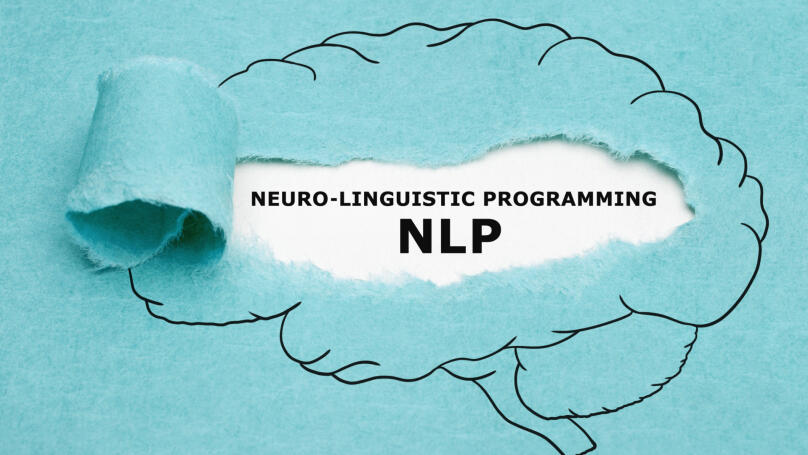Neuro linguistic Programming (NLP)

What is neuro linguistic programming and how it works
Neuro linguistic programming (NLP) is a branch of psychology that studies the influence of human thinking on their behavior. NLP is also referred to as a particular behavior pattern by which one interlocutor seeks to influence another through verbal and nonverbal communication.
The NLP key idea is the claim that anyone can become successful. All one needs to do is to replicate the behavior of outstanding people. In other words, neuro linguistic programing involves modeling and applying well-known behavior techniques and rules that help a person to achieve certain goals, both in self-development and interpersonal communication.
Thus, NLP methods lie at the junction of several fields - psychology, programming and linguistics. Researchers argue that there is a direct connection between the neurological processes going on in each person's body, their means of communication and behavior patterns. This approach allows for a wide range of applications, so NLP techniques can be used in many different areas - psychotherapy, education, management, law, marketing and sales
NLP techniques can help you control your own mood, emotions and feelings. And once you gain control over your brain, NLP enables you to influence others, to convince people in a professional way and prove your case. This skill will come in handy for managers and executives alike. In fact, NLP is a set of techniques applicable in all areas of life, and most often it is about convincing other people.
Proponents of this concept believe that practicing NLP training techniques improves, amongst others, physical and psychological well-being, helps you to cope with anxiety and various health problems such as obsessive compulsive disorder, eating disorders, post-traumatic syndrome and dyslexia.
NLP History
The NLP theory emerged in the second half of the 20th century. In the 1960s-70s, a group of researchers at the University of California began to develop their own model of practical psychotherapy. Psychologist Richard Bandler and linguist John Grinder studied Gestalt and hypnotherapy techniques. For example, they analyzed the work of psychotherapists Virginia Satir, Fritz Perls and Milton Erickson. The well-known anthropologist Gregory Bateson, who studied the nature of human cognition, also significantly influenced the young researchers. It was his way of thinking that later became one of the benchmarks for the NLP creators.
Richard Bandler and John Grinder set out their concept in a two-part book, The Structure of Magic, published in 1975. They summarized the experience and knowledge of the best mental health experts and developed a unique neuro linguistic programming model calling its effect a "therapeutic magic". This is how the idea of replicating the behavior of successful people began to gain ground.
Over time, the scientific theory gained popularity, and by the late 1970s, NLP caught interest of both scholars as well as the public. The technique has become widespread as an essential practical tool in learning the secrets driving success in careers, personal life and negotiations. Despite the fact that from 1980 the NLP founders no longer cooperated with each other, they continued to elaborate their ideas. In addition, their writings formed the basis of further research in the field. Largely thanks to Bandler and Grinder, neuro linguistic programming methodology is constantly supplemented and modified; it has many followers and continues to evolve.
NLP basic principles

The neuro linguistic programming basic principles are the following:
- A map is not a territory
It is a metaphor used to illustrate the difference between the real world and our subjective understanding of it. That is, just as a geographical map is not really a natural terrain or territory, so our speech, appearance, and behavior are not an absolute reflection of our experience and worldview. NLP techniques involve changing perceptions of reality; they do not deal with reality per se.
- Personality and behavior is not the same thing
This principle follows logically from the preceding idea. In other words, a person is much more than just their behavior. Some actions may be unintentional, so behavior does not describe individuals themselves. Personality is always much broader and more significant than some fleeting action.
Only by recognizing that a person's behavior differs from their personality we can expect a person to behave differently in another situation. After all, behavior depends on a multitude of subjective and external factors. That is, it is context-dependent. So, if you offer a different context, the person will behave in a different way.
- Failures don't exist - there are only lessons learned.
There isn't even a concept of failure in NLP. That is, any actions, both successful and unsuccessful, are not a reason for resentment, disappointment or concern, but valuable information that will help you avoid similar mistakes in the future.
- Body and mind are one
This basic principle implies that our body and mind are interconnected and inevitably influence each other. All the nerve cells in our body - of which there are about 100 billion - are connected to each other even on the physical level. So, NLP methods draw deeply on psychosomatics - an area in medicine and psychology. It essentially studies how a person's feelings and emotions affect their physical health.
-
Cognitive flexibility is a critical skill for success
Cognitive flexibility (flexible thinking) is a person's ability to adapt to new circumstances, find effective solutions to problems in crisis situations and think creatively and unconventionally. That is, a person with a highly flexible mind and, consequently, behavior, is able to consider a situation from different angles, analyze all its aspects and even the seemingly smallest details. For this reason, they have a powerful influence, the ability to influence others, which is NLP's most important objective.
NLP techniques

NLP most important techniques are practice-oriented enabling to get answers to questions such as:
- "How should I react to my thoughts and emotions?"
- "How do I adapt my communication style to a certain situation?"
- "How do I change my thinking?"
There is a variety of NLP training exercises, but there is no clear-cut classification. They can, for convenience, be categorized into techniques aimed at oneself and self-development, as well as the ones for persuading other people.
Self-development techniques:
- Imaginary (mental) practice.
This is an NLP classic technique based on visualization. It is sometimes called "mental rehearsal". The method involves imagining a certain situation in which you successfully cope with all the tasks. For example, you defend your project, make a presentation to sponsors, have a job interview, or an exam.
You have to create in your own imagination the clearest possible picture, with all the details. At the same time, be aware of your body, sense your breathing and listen to your heartbeat in order to connect your thoughts with your bodily reactions.
- NLP Swish
This is also a visualization technique, but somewhat more complex than the previous one. NLP swish involves creating two images in your mind at once. The first is an adverse one, that is, what you do not wish for yourself. Imagine your failure, flop, loss as accurately and vividly as possible. You should get a large-scale and credible picture of your defeat. But don't get panicky yet! After this, imagine a situation, which you would like to replace your failure in the previous picture. Now recreate what you dream of: a successful job interview, an excellent exam result or a successful project pitching. Keep in mind that you should visualize all this most vividly.
Once you have recreated the two conflicting images, you need to compare them. Once you present these images side by side, bring the positive dream picture to the forefront. What you dream about should overlap the failure picture. The adverse image will gradually get smaller and fade, and your triumph picture, on the contrary, will increase and acquire bright colors. It is a good idea to repeat this technique three to five times.
- Modeling
This technique is based on the law of attraction and suggests that you should be as close to successful people as possible, in other words, surround yourself with people who have achieved the desired success. This will enable to focus on modeling that is, replicating their behavior. For example, you can find a mentor among your colleagues or take an example from your boss. Remember that the more role models you have, the more successful you will be in mastering the modeling technique. This is NPL core idea - to become successful, you need to interact with successful people and behave accordingly.
- Framing
Framing is about changing the person's focus or angle of their perception of a situation. It is the most appropriate technique when an adverse event has already occurred. In such a case, it is essential to look at the situation from a different angle, analyze it, find positive aspects, or at least draw valuable conclusions. For example, do not despair, if you fail a job interview. First of all, breathe out. After that you should fill the gaps in your knowledge, update your resume or even try your hand in a different field of activity.
Techniques for persuading other people
- Mirroring
In the 1970s, psychologist Albert Meyerabian came up with the 7%-28%-55% rule. It means that only 7% of information is transmitted by words, 38% - through the voice tone and the rhythm of speech and 55% - by body language. So, mirroring is an NLP technique that uses body language to establish instant rapport and connection with anyone. To do this, it is necessary to mimic the body language of your interlocutor. For example, if he is relaxed, you should not be tense either. You can also adjust to your interlocutor through speech, imperceptibly replicating their manner or key phrases. Simply put, this technique involves mirroring the person. If you observe your interlocutor and subsequently mimic some of their gestures, postures or words, they will relate to you with more trust simply because you are like them.
- The Three Yes Rule
This is a manipulation technique which allows to influence people's subconscious. It is based on the law of inertia: in order to build trust, you need to ask your interlocutor only 3 questions, the answer to which will be a confident Yes. So their thinking will move in the right direction, and the interlocutor will tend to agree with you in future.
- Attention shifting
Attention shifting aims, like framing, to change the focus of your interlocutor. That is, you need to ask an unexpected question in order to shift their attention to another topic or another object. It is common knowledge that our brain, eyesight and attention can in general focus on one thing only. By abruptly changing the topic, you will make your interlocutor "switch," and then return to the original topic of your conversation. As a result, your interlocutor will lose concentration and become more malleable.
- Anchoring
An emotional anchor is a kind of trigger, that is, a specific and distinctive stimulus that triggers a particular emotional response in a person. In other words, an emotional anchor is a signal to the subconscious that causes us to re-experience certain situations and states. It can be visual, auditory and kinesthetic (that is, involving sensations and touches, smells and tastes). Such anchors can be created artificially, for example so that communication with a certain person will elicit pleasant associations in your mind.
Best NLP books

This selection of books on neuro linguistic programming offers the most insightful and helpful ones where the authors share their own experience with NLP methods they use on a regular basis. So, the most effective guides on NLP techniques are listed below:
- From Frogs to Princes. Neurolinguistic Programming. The authors Richard Bandler and John Grinder were the first ones to substantiate the NLP concept. This book is a major one in practical psychology providing basic knowledge of NLP, its key techniques and methods.
- NLP Workbook: A Practical Guide to Achieving the Results You Want. A bestseller by Joseph O'Connor, who is not just a theorist but also an NLP trainer and consultant. This publication teaches, above all, how to apply what he has learned in practice. O'Connor considers affirmations and self-suggestion one of NLP most important techniques, so they, as well as algorithms for their competent use, take a special place in the book.
- Tricks of the Language. Changing Belief Systems with NLP. Its author is an NLP practitioner Robert Dilts. He outlines NLP key techniques and methods, focusing on how to persuade interlocutors and suggest them certain information. According to Robert Dilts, it is a person's speech that has the greatest impact on other people, so it is possible to change human consciousness using certain speech patterns.
- NLP Practice. Bob Bodenhamer and Michael Hall's compendium contains only NLP most essential knowledge and effective techniques.
- NLP: The New Technology for Achievement. Steve Andreas and Charles Volker's book explains NLP most basic and essential principles. Its very simple and comprehensible language makes it most relevant to NLP beginners.
But the best way to master the subject is through various NLP online courses and training sessions. For example, NLP in Sales. Powerful psychological techniquesfrom Lectera.
Conclusions
NLP application scope is extremely broad. Some psychologists use neuro linguistic programming techniques to treat fears and phobias, as well as low self-esteem, stress and post-traumatic syndromes, alcohol and drug addiction. Meanwhile, the NLP impact on mental health continues to be studied and expand its horizons. NLP techniques obviously affect the subconscious, changing the person's inner beliefs, helping them to become successful, to change the reality and even the people around them. So, such a simple opportunity to change the world should not be neglected!























